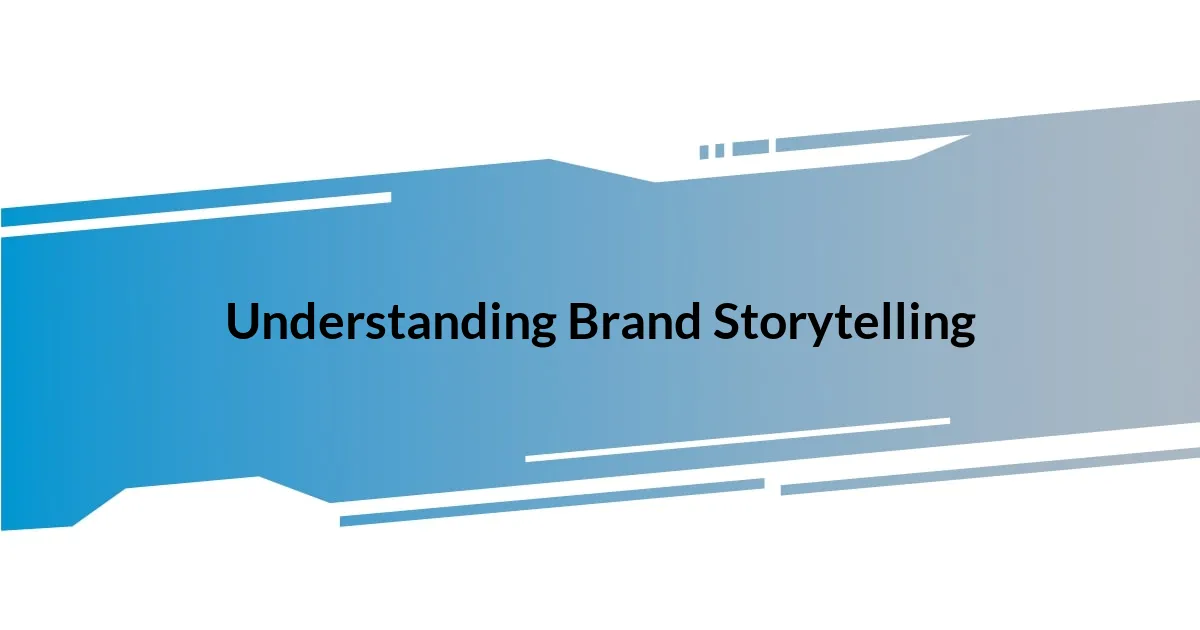Key takeaways:
- Brand storytelling emphasizes emotional connections over mere facts, showcasing vulnerability and authenticity.
- Defining your brand identity, including values and unique selling proposition, is crucial for effective storytelling.
- Understanding your target audience’s demographics and psychographics optimizes the relevance and impact of your narrative.
- Visual storytelling enhances engagement, making messages more relatable and emotionally resonant through the use of images and videos.

Understanding Brand Storytelling
Brand storytelling is about creating a narrative that resonates deeply with your audience. I remember when I first crafted a story for my own brand; I focused not just on what we did, but on why we did it. This shift from facts to feelings paved the way for a connection that felt genuine and personal, and it encouraged others to share in that journey.
It’s fascinating how a well-told story can evoke emotions and cultivate loyalty. Have you ever noticed how certain brands make you feel? I’ve found that when I share challenges and triumphs through storytelling, it humanizes the brand. For instance, sharing a moment where my team overcame adversity not only highlighted our brand’s resilience but also helped our audience see us as relatable figures in their own lives.
Moreover, understanding that everyone loves a good story can change how we approach our brand’s messaging. I often ask myself, what elements of my narrative will resonate with my audience? When I infused personal experiences into the brand’s journey, I could not only inform but also engage in a way that felt dynamic. This interaction becomes the soul of brand storytelling, making it a powerful tool for connection.

Defining Your Brand Identity
Defining your brand identity is the cornerstone of effective storytelling. I’ve found that creating a clear identity involves introspection and understanding what truly sets your brand apart. Reflecting on my own journey, I remember sitting down with my team and mapping out our core values, mission, and vision. This process not only clarified our purpose but also created a touchstone we could always refer back to.
To help you narrow down your brand identity, consider these key aspects:
- Core Values: What principles guide your brand’s decisions and actions?
- Target Audience: Who are the people you want to connect with, and what do they care about?
- Unique Selling Proposition (USP): What makes your brand different from others in your industry?
- Brand Personality: If your brand were a person, how would you describe its characteristics (e.g., friendly, innovative)?
- Visual Identity: What colors, fonts, and imagery reflect your brand’s essence?
By diving into these elements, you can create a robust foundation that informs every story you share, ensuring it’s not just compelling but also authentically you.

Identifying Your Target Audience
Identifying your target audience is a crucial step in crafting compelling brand stories. When I started delving into this aspect, I realized the importance of understanding not just demographics but also psychographics—like values, interests, and lifestyles. For example, I once focused on a specific age group for a promotional campaign, but it wasn’t until I considered the audience’s motivations that I saw a real shift in engagement. It’s interesting how knowing their aspirations changes the narrative you create.
One of the most eye-opening experiences for me was conducting surveys and interviews with potential customers. I was amazed at how much insight I gained from these conversations. By asking about their pain points and preferences, I could tailor our storytelling to resonate deeply with their experiences. This connection became the backbone of the stories we shared, and it felt rewarding to see our audience respond positively.
Being aware of the nuances in your audience’s lifestyle makes a significant difference. It allows you to incorporate relevant themes that resonate. For instance, I recall launching a campaign that highlighted sustainability, knowing my audience valued eco-friendly practices. This alignment helped elevate our narrative and created a sense of community among our followers. Recognizing who you’re speaking to not only guides your storytelling but ensures that your brand message feels relevant and impactful.
| Aspect | Description |
|---|---|
| Demographics | Age, gender, income level, education background. |
| Psychographics | Interests, values, lifestyle, and behaviors that drive decision-making. |
| Feedback | Insights gathered from surveys and conversations can shape your narrative. |
| Engagement | Understanding what resonates can enhance audience interaction with your brand. |

Crafting a Compelling Narrative
Crafting a compelling narrative starts with understanding the heart of your brand’s story. I remember when I stumbled upon the idea of using personal anecdotes in our storytelling. It was during a marketing meeting when a team member shared an experience that highlighted our brand’s mission in action. That moment clicked for me; I realized that weaving real-life stories made our messages relatable and authentic. Isn’t it fascinating how a simple story can illustrate complex values?
Another essential aspect is the emotional journey you want your audience to embark on. I once created a campaign that followed the journey of a customer facing a challenge that our product could solve. Watching that story unfold was powerful; it connected with our audience on a deeper level. It made me think, how do you want your audience to feel when they interact with your brand? Fostering that emotional connection can turn casual viewers into passionate advocates.
Additionally, consider how your landscape influences your narrative. I vividly recall when market trends began shifting toward digital experiences. We pivoted our storytelling approach to highlight convenience and innovation, tapping into the zeitgeist. This is where I learned that your narrative should evolve, just like your brand and audience do. Adapting to changes in sentiment and expectations can make your storytelling not just relevant, but compelling. What narratives do you see resonating with people around you?

Utilizing Visual Storytelling Techniques
Visual storytelling is a powerful tool that can transform how your brand communicates its message. I vividly remember a time when I participated in a project that relied heavily on visuals instead of text. We focused on creating a series of infographics that illustrated our product’s benefits. The results were astounding; engagement skyrocketed because visuals often resonate more deeply than words alone. I believe a well-crafted image can tell a thousand stories; isn’t it incredible how a single visual can convey complex ideas instantly?
In my experience, using video content can elevate your storytelling to new heights. I once collaborated on a short documentary that showcased the journey of a product from conception to delivery. Watching the audience react emotionally during the screening made it clear how visual storytelling can foster a sense of connection and authenticity. Have you ever noticed how it feels different to see a narrative unfold through visuals versus reading about it? That emotional engagement is what I strive for in every project.
Additionally, utilizing colors and imagery strategically can evoke specific emotions and reinforce your brand identity. I experimented with color palettes in our social media graphics, aligning them with the feelings we wanted to evoke. For example, warmer tones created a sense of community and warmth, while cooler hues conveyed professionalism and trust. It’s remarkable how these choices impact how people perceive our brand. What emotional response do you want to elicit from your audience, and how can visuals help you achieve that?

Engaging with Your Audience
Engaging with your audience is all about creating meaningful interactions. I once launched a campaign that invited our customers to share their own stories using our product. The response was overwhelming and heartwarming; it felt as if we were part of a larger community. I’ve learned that when you allow your audience to express themselves, they form a genuine connection with your brand. Have you ever tapped into this power?
Listening to your audience is just as crucial as sharing your brand story. I remember organizing a feedback session where we simply asked customers what they loved and what they wanted to see improved. The insights were enlightening, and we altered our messaging to align with their needs. This process reinforced that real engagement comes from understanding your audience’s voice. How often do you invite feedback in your brand conversations?
Lastly, I believe in the magic of storytelling through dialogue. During a live Q&A session, a customer asked a question about our brand that I hadn’t anticipated. Their eagerness to engage created a dynamic conversation that not only informed others but also strengthened our relationship. It made me ponder, how can these spontaneous interactions shape your narrative? Embracing dialogue can turn a one-sided message into a shared experience, highlighting the true essence of your brand.